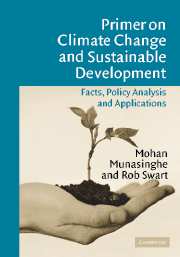Book contents
- Frontmatter
- Contents
- Foreword
- Preface
- 1 Climate change: scientific background and introduction
- 2 Future scenarios of development and climate change
- 3 Framework for making development more sustainable (MDMS): concepts and analytical tools
- 4 Interactions between climate and development
- 5 Adaptation to climate change: concepts, and linkages with sustainable development
- 6 Vulnerability, impacts, and adaptation by sectors and systems
- 7 Vulnerability, impacts, and adapation by geographic region
- 8 Mitigating climate change: concepts and linkages with sustainable development
- 9 Mitigation measures: technologies, practices, barriers, and policy instruments
- 10 Assessment of mitigation costs and benefits
- 11 Climate change and sustainable development: a synthesis
- Index
- References
6 - Vulnerability, impacts, and adaptation by sectors and systems
Published online by Cambridge University Press: 25 December 2009
- Frontmatter
- Contents
- Foreword
- Preface
- 1 Climate change: scientific background and introduction
- 2 Future scenarios of development and climate change
- 3 Framework for making development more sustainable (MDMS): concepts and analytical tools
- 4 Interactions between climate and development
- 5 Adaptation to climate change: concepts, and linkages with sustainable development
- 6 Vulnerability, impacts, and adaptation by sectors and systems
- 7 Vulnerability, impacts, and adapation by geographic region
- 8 Mitigating climate change: concepts and linkages with sustainable development
- 9 Mitigation measures: technologies, practices, barriers, and policy instruments
- 10 Assessment of mitigation costs and benefits
- 11 Climate change and sustainable development: a synthesis
- Index
- References
Summary
Natural and human systems are exposed to variations in climate. These include changes in average range and variability of temperature and precipitation as well as the frequency and severity of weather events. Some indirect effects of climate change include sea-level rise, changes in soil moisture and land and water conditions, changes in frequency of fire and pest infestation, and the distribution of disease vectors and hosts. The potential for a system to sustain adverse impacts is determined by its capacity to adapt to the changes.
Hydrology and water resources
Impacts of climate change on hydrology and water resources
Water stress is becoming an apparent problem in many parts of the world. The amount of water available per person is decreasing, whereas the ratio of volume of water withdrawn to volume of water potentially available is increasing (Arnell 1999; 2000), (see Figure 6.1).
This water stress is caused by many socioeconomic and natural changes unrelated to climate change, but is likely to be exacerbated by climate change. Approximately one-third (1.7 billion) of the population of the world presently live in countries that are water-stressed, i.e. using more than 20 per cent of their renewable water supply. This number is expected to increase to 5 billion by 2025.
Water, once revered for it's life-giving properties, has become a commodity. Throughout the world, human use of water has already led to dried-up and polluted rivers, lakes, and groundwater resources. Potable water is becoming increasingly scarce.
- Type
- Chapter
- Information
- Primer on Climate Change and Sustainable DevelopmentFacts, Policy Analysis, and Applications, pp. 207 - 230Publisher: Cambridge University PressPrint publication year: 2005

